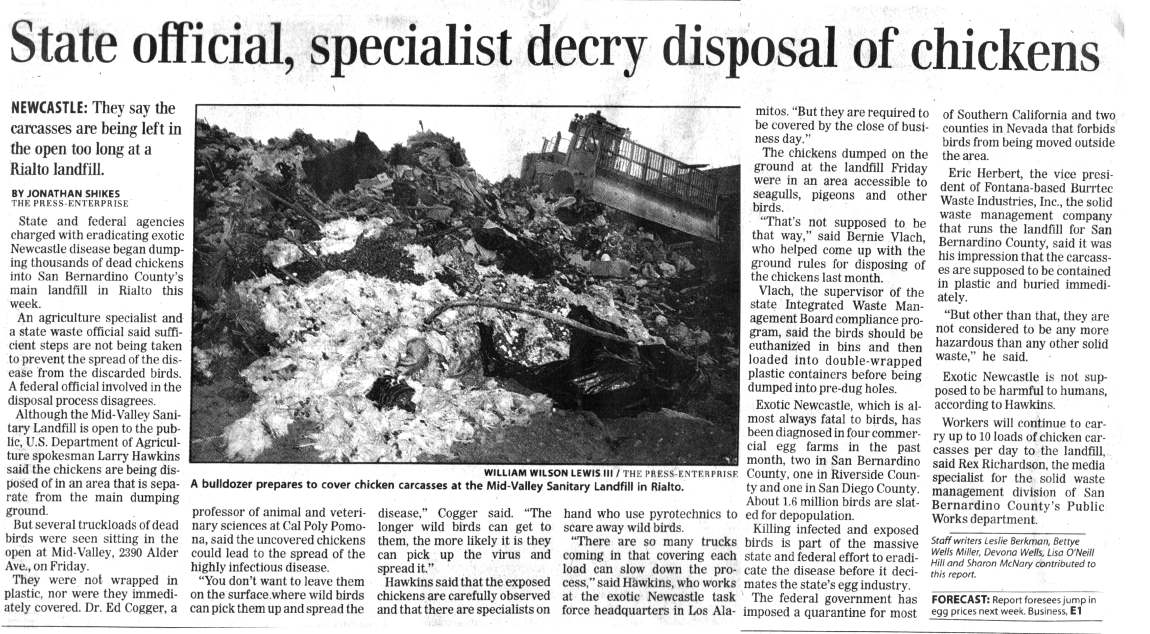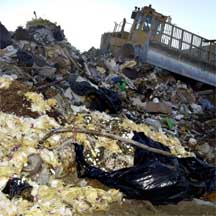

PLEASE READ: In the wake of the END outbreak and depopulation, some atrocious things have been discovered. This is but one of them.
The credit you for uncovering this horror goes to the Press-Enterprise. Had this story not be discovered and published, it is frightening to think how long this would have gone on! Thank you especially Jonathan Shikes and William Wilson Lewis III.
There have been two follow up stories so far, the last dated January 31, 2003. They are both on this page. Please note, however, that the Federal Regulations, for which there is a link below, still require the birds be covered with soil and NOT compacted trash or otherwise.
What they are doing is totally contrary to the proper disposal methods per the Federal Regulations. In fact, they are supposed to be buried 6 feet deep! Proof of this statement - (LINK)
Seeing this picture in color will bring you to tears - Click here (LINK)

Bird landfill rules changeDISPOSAL: State officials say chickens destroyed in a bid to curb disease have to be buried immediately.
01/22/2003
Regulators overseeing the disposal of nearly 2 million chickens ordered Inland landfills to cover the carcasses immediately with dirt Tuesday as they tried to stop the spread of exotic Newcastle disease.
That is a marked change from an earlier practice that left dead birds exposed in piles 20 feet high or covered with trash until day's end, when bulldozers shoved them into plastic-lined pits.
Now, bulldozers will cover chickens in dirt as they arrive to keep wild birds from picking at the carcasses and spreading disease, state agriculture officials said.
A task force that is fighting the virus met with landfill operators Tuesday to clarify the procedures, said Larry Cooper, spokesman for the California Department of Food and Agriculture.
A story and photographs in Saturday's Press-Enterprise showing birds exposed at the dump caused concern and prompted the review, he said.
"We were not aware that some of these people were not following procedures," Cooper said.
Operators of Mid-Valley Sanitation Landfill in Rialto and El Sobrante Landfill south of Corona had been covering carcasses in trash as late as Tuesday. As late as Tuesday, landfill operators thought they were doing the right thing covering the carcasses in trash, Cooper said.
Last week, a U.S. Department of Agriculture official said there were so many truckloads of dead birds that covering each load would slow the burial process.
But trash does not necessarily offer an adequate barrier to keep animals and birds away from the virus, said Richard Breitmeyer, the state veterinarian.
The policy review began over the weekend after some agriculture experts told The Press-Enterprise that carcasses should be buried or incinerated immediately to keep wild birds from spreading the disease.
Exotic Newcastle is almost always fatal to birds. It is a dreaded threat in the Inland area, which produces 40 percent of California's eggs.
The virus has turned up so far in four commercial egg farms in the past month, two in San Bernardino County, one in Riverside County and one in San Diego County. The task force plans to destroy about 1.7 million chickens and 73,000 backyard birds, including ducks, doves and cockatiels.
Killing infected and exposed birds is part of the state and federal effort to eradicate the disease before it decimates the state's egg industry.
At the El Sobrante Landfill south of Corona, booms from a propane canon echoed through the rolling hills on Tuesday afternoon.
The landfill operators installed the noisemaker in recent weeks to scare seagulls and other fowl from the massive dump, said Damon DeFrates, district manager for Waste Management, the landfill operator. The landfill keeps dead chickens, eggs, manure and other debris infected with or exposed to the virus far away from public areas.
Landfill officials get prior notice of a load of dead chickens or other infected material. On Tuesday, workers dumped carcasses into a massive pit marked with fluorescent orange cones. A bulldozer covered the birds with a layer of regular trash, which was then covered with composted green waste and dirt, DeFrates said.
That practice was to change to require immediate covering with a layer of dirt, Cooper said.
Joseph McCann, general manager and chief engineer for Riverside County Waste Management, said he expects to meet this week with University of California farm adviser Doug Kuney for further review of carcass disposal.
"We want to be sure we are tying up any loose ends," he said.
The Badlands landfill east of Moreno Valley and Lamb Canyon landfill near Beaumont also accept birds and eggs from infected ranches, McCann said. Normally landfills can't take any loads that are more than 50 percent liquid, he said, but the Santa Ana Regional Water Quality Control Board has made an exception in this case for eggs where landfills are lined with plastic.
Peter Wulfman, division manger for San Bernardino County Waste Management, said he visited the Mid-Valley Sanitation Landfill on Tuesday after seeing photographs of exposed chickens in The Press-Enterprise.
He observed workers covering carcasses immediately in trash and spraying trucks with disinfectant before they left for another load, Wulfman said. He left satisfied thinking that was proper procedure, he said.
The federal government has imposed a quarantine for most of California and two counties in Nevada that forbids birds from being moved outside the area. Oregon, Washington and Arizona recently banned the importing of birds from quarantined areas.
Oregon has no agricultural inspection stations at its borders, but may consider some type of checkpoint to enforce the quarantine, said Andrew Clark, Oregon's state veterinarian.
Dumping infected chickens in landfills is an acceptable disposal method, he said, as long as they are buried quickly. "The sooner the better," he said.
Leslie Berkman can reached by email at lberkman@pe.com.
David Danelski can reached by email at ddanelski@pe.com.
Online at: http://www.pe.com/localnews/stories/PE_NEWS_nachick22.a197e.html
Landfill changes chicken burialsDISEASE: Riverside County officials tell a task force that compacted trash works as a cover.
01/31/2003
Riverside County waste management authorities said this week that they have received state and federal approval to cover hundreds of thousands of chicken carcasses with compacted trash instead of dirt.
The chickens are from Inland egg ranches infected with exotic Newcastle disease, a highly contagious virus almost always fatal to birds. About 2 million hens, mostly from Inland commercial egg operations, have been or will be destroyed to try to stop the disease from spreading.
Covering the dead chickens with dirt, as the exotic Newcastle task force had wanted, is unfeasible and a waste of landfill space, said Matthew Hickman, who is overseeing the chicken disposal program for the Riverside County Waste Management Department.
Hickman said his plan calls for covering each new load of chickens with compacted trash within 10 minutes.

William Wilson Lewis III
The Press-EnterpriseA bulldozer prepares to cover dead chickens with trash at the Mid-Valley Sanitary Landfill in Rialto on Jan. 17. How to properly dispose of chickens exposed to exotic Newcastle disease has been a subject of debate. Doug Kuney, a poultry expert and farm adviser at UC Riverside, said he worked last week with Hickman, other county officials and Waste Management Inc., the private company that runs the El Sobrante Landfill south of Corona, to develop a 15-minute videotape to train landfill workers. The tape was forwarded to the Newcastle task force, Kuney said.
Kuney said task force leaders from the U.S. Department of Agriculture and California Department of Food and Agriculture told him this week that they approved of the procedure depicted in the tape.
"We concur with the new procedure for burying poultry, as long as the volume of trash creates a sufficient seal that would be equivalent to that one created when using soil," said Leticia Rico, task force spokesperson.
Hickman and Kuney said they had hoped the video could be used as a guideline for other landfills involved in the eradication program.
"We work with the landfills, but we don't make decisions for the local landfills," Rico said. She said the task force is still evaluating the biosecurity content of the video.
The tape shows how 12 feet of commercial trash can be compacted into a 3-foot cover, Kuney said. The cover is impervious to sea gulls and scavengers that could spread exotic Newcastle disease.
Hickman said the need for formalized guidelines became apparent when The Press-Enterprise reported on Jan. 18 that several truckloads of dead birds were seen sitting in the open at the Mid-Valley Sanitary Landfill in Rialto, San Bernardino County's main landfill.
Hickman said that, before then, he had been unable to get guidance from the joint state and federal task force on how to dispose of the birds.
"I had been requesting a procedure and never got any," he said. "I received birds before I received procedures."
Responding to Hickman, Rico said that "task force staff have worked closely with all landfill staff to accomplish safe and biosecure disposal practices."
Hickman said the tape shows how to separate trucks and bulldozers carrying dead birds from other landfill traffic and how to designate an area to wash the vehicles with disinfectant.
So far, 1.5 million hens from commercial farms and 81,254 backyard birds in Southern California have been destroyed, and another nearly 285,000 birds are scheduled for euthanasia. The vast majority are being buried in San Bernardino and Riverside counties.
Last week, operators of the Mid-Valley and El Sobrante landfills said they were covering each load of chicken carcasses with trash, which was capped at the end of the day with a foot of dirt, as required by state regulations.
The task force said it clarified to landfill operators that each new load of chicken carcasses should be covered immediately with dirt, not trash. State Veterinarian Richard Breitmeyer said a dirt burial was the scientifically accepted practice for disposing of any dead animal.
Rex Richardson, media specialist for the solid waste management division of San Bernardino County's Public Works department, said that, as of Jan. 22, dirt burial of chickens became the procedure at Mid-Valley.
Hickman said he was determined to persuade the task force that compacted trash would work. His success came just in time for the El Sobrante Landfill on Monday to begin burying about 250,000 chickens euthanized at a Norco farm owned by Norco Ranch, one of Southern California's largest egg producers and marketers.
"I created a video and told them (federal and state agricultural authorities) what modern landfills were capable of doing," Hickman said. He added that if a dirt cover had been required, the landfill couldn't have accepted the birds.
Reach Leslie Berkman at (909) 893-2111 or lberkman@pe.com
Online at: http://www.pe.com/business/local/PE_BIZ_nchickn31.a19a4.html